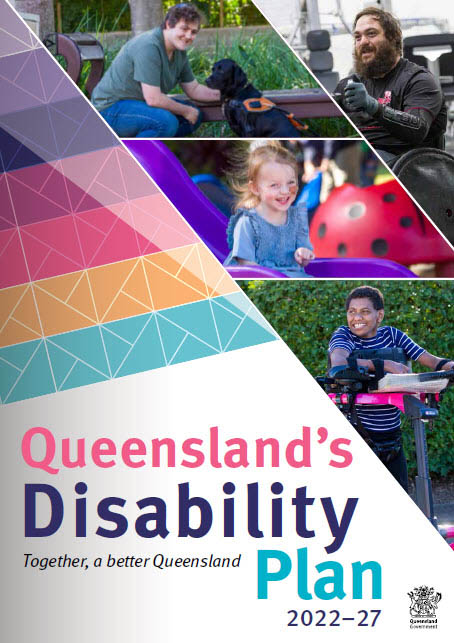Queensland's Disability Plan 2022-27
Queensland’s Disability Plan 2022-2027: Together, a better Queensland, is Queensland’s plan to build an inclusive Queensland.
You can:
- A summary version of the plan will be available shortly.
- Braille available on request by emailing: feedback@dsdsatsip.qld.gov.au
Acknowledgments
Cultural acknowledgement
In the spirit of reconciliation, the Queensland Government acknowledges the Traditional Custodians of country throughout Australia and their ongoing connection to land, sea and community.
We pay respect to Elders past and present and extend that respect to all Aboriginal and Torres Strait Islander peoples.
Australia’s Disability Strategy
The development of Australia’s Disability Strategy 2021–2031 involved extensive national consultation and engagement with the disability sector, including peak and representative bodies, governments and, most importantly, people with disability. In preparing Queensland’s Disability Plan, we acknowledge and respect the critical contributions that people with disability have made to the development of the ADS.
On 3 December 2021, Queensland’s Premier, The Honourable Annastacia Palaszczuk MP, signed and confirmed our commitment to Australia’s Disability Strategy.
A note on the language of disability
Disability is wide-ranging and comes in many forms. We acknowledge that the language around disability is evolving and there is active debate in the community and different preferences about ways to describe disability.
We acknowledge the importance of having conversations with individuals about their preferred language and not making assumptions.
It is critical to respect individual preferences. Some people prefer to be referred to as a ‘person with disability’ and others prefer ‘disabled person’. Others prefer the use of language such as ‘diverse abilities’ rather than disability.
The language used in this plan is not intended to indicate a particular preference and we do not intend to exclude anyone on the basis that their preference differs to the style used. This plan is for all people with disability and diverse abilities, and we welcome feedback on the language of disability.
We recognise that many people’s experiences as a person with disability are intersectional and can be shaped by not only their disability but their age, sex, gender, gender identity, sexual orientation, intersex status, ethnic origin or race.
The disability community is broad and diverse and it is important to recognise that not all disability is visible to others.
Minister’s Message
Queensland is the state of opportunity—and everyone in our state deserves the opportunity to reach their potential.
All of us have goals and aspirations for our personal, social, economic and professional lives, and we all need the right supports around us to achieve those things.
Queensland’s Disability Plan 2022–27: Together, a better Queensland is the first state plan since the full transition to the National Disability Insurance Scheme.
Building on the previous plan, this plan represents a new phase in action. It will drive implementation of the seven outcome areas as outlined in Australia’s Disability Strategy in a way that encompasses the unique aspects of Queensland’s peoples, regions and diversity.
In 2022, more than 900,000 Queenslanders live with disability, and we are committed to making sure each and every one has what they need to live their best lives as equal citizens.
This plan was developed in collaboration with people with disability, putting their lived experiences and needs at the centre, championing people with disability to be central to design and decision making on things that impact their lives.
We expect more than 180,000 Queenslanders will be participating in the National Disability Insurance Scheme (NDIS) in the next 10 years, including First Nations peoples, people from culturally and linguistically diverse backgrounds, and those living in rural and remote communities and our regions.
Our task ahead is to improve access to education, employment, appropriate housing, and a society without barrier or stigma, and this plan outlines priorities to achieve these outcomes.
Queensland Government departments will develop, publish and deliver action plans that align with and implement Queensland’s Disability Plan 2022–27: Together, a better Queensland.
It is important to recognise that creating a disability-inclusive state is a job for everyone, not just government.
I invite and encourage all levels of government, businesses, industries, organisations and communities to make the same commitment to work collectively and with people with disability to improve access and inclusion.
Together, we can build an inclusive Queensland and make sure that everyone has what they need to fulfil their potential as equal members of our community.
The Honourable Craig Crawford MP
Minister for Seniors and Disability Services
Minister for Aboriginal and Torres Strait Islander Partnerships
1. Introduction
1.1 Context
Internationally, the United Nations Convention on the Rights of Persons with Disabilities (UNCRPD) provides the framework to promote and protect the human rights of people with disability. Australia has adopted the UNCRPD and is implementing it through Australia’s Disability Strategy 2021–31 (Australia’s Disability Strategy).
Australia’s Disability Strategy has been co-designed with people with disability to provide a strategic framework and outline of the outcomes we need to achieve to advance the human rights of people with disability. It calls on all Australians to create an inclusive Australian society that ensures people with disability can fulfil their potential, as equal members of the community1.
The Queensland Government is committed to celebrating the value people with disability bring to our community and ensuring people with disability can live their best lives in our state. We have demonstrated this commitment by, along with all other states and territories, becoming a signatory to Australia’s Disability Strategy.
The intention of this new plan is to be the primary mechanism to drive implementation of Australia’s Disability Strategy in Queensland. Queensland Government departments will be required to develop, publish and deliver key actions under Queensland Government disability service plans that align with this plan. We will also invite and encourage all levels of government, businesses, industries and communities to make the same commitment—to work collectively and with people with disability towards a common objective of access and inclusion.
In addition to Australia’s Disability Strategy, the Queensland Government also implements the UNCRPD through a range of statutes, including the Human Rights Act 2019, the Disability Services Act 2006 (DSA) and the Anti-Discrimination Act 1991.
The collective framework established by UNCRPD, Australia’s Disability Strategy, legislation, this plan and disability service plans, form Queensland’s commitment to upholding and promoting the rights of people with disability.
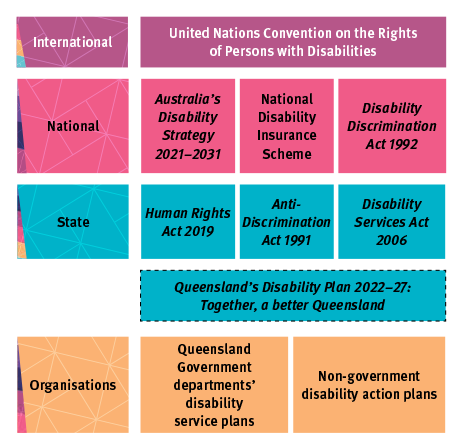
1.2 People with disability in Queensland
This plan is designed to promote access and inclusion for all Queenslanders with disability.
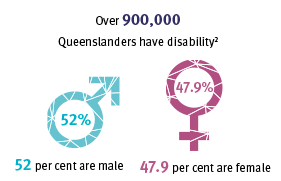
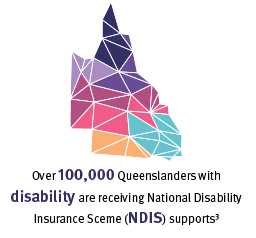


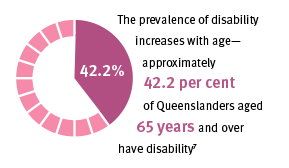
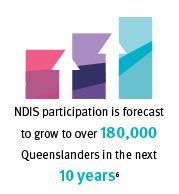

2. Informing this plan
2.1 All Abilities Queensland
Under the former State Disability Plan, All Abilities Queensland: Opportunities for All (2017-2022), Queensland Government departments took action to support the economic and social participation of people with disability through the five priority areas:
- communities for all
- lifelong learning
- employment
- everyday services
- leadership and participation.
Implementing All Abilities Queensland was a coordinated effort across the Queensland Government, and partnerships with the Commonwealth Government, local government, businesses, non-government organisations and communities.
Implementation was undertaken during a significant period of change. Queensland’s transition to the NDIS was the centrepiece of this change.
The NDIS has fundamentally changed how people with disability obtain supports and services. The All Abilities Queensland plan was designed to align with the timeframe for transition to the NDIS in Queensland and included actions that coordinated this work across the Queensland Government and disability sector.
All actions committed to under All Abilities Queensland have been successfully delivered and the learnings have informed this plan. A comprehensive report on the outcomes of All Abilities Queensland is available at: All Abilities Queensland Final Progress Report .
2.2 Co-design with the All Abilities Working Party
A key part of developing this new plan was collaborating with people with disability to reflect on the implementation of All Abilities Queensland.
This work was led by Queenslanders with Disability Network, through a working party comprised of people with lived experience of disability, to impartially review the actions taken under All Abilities Queensland. It provided a strong starting point for this plan’s development.
The working party also played a key role in the co-design of this plan, making recommendations about the importance of listening to, engaging with and seriously considering the views of people with disability. This is a core element of inclusion and placing greater emphasis on it will provide the best possible input to the future design of products, services and places, which will in turn deliver better outcomes for people with disability.
The working party’s key message to government was:
A great state disability plan is one that is aspirational, alive, responsive and makes a real difference in people’s lives; it will be based on human rights, co-design, outcomes measurement and maximisation of economic and human potential, and commitment to cultural change. All Abilities Queensland Working Party, 2021.
3. How we will build an inclusive Queensland
3.1 What we are trying to achieve
The working party gave detailed consideration to the outcomes framework developed for Australia’s Disability Strategy and concluded it was logical and appropriate for the Queensland State Disability Plan to align. While it is important that Australia’s Disability Strategy be read in conjunction with this plan, the working party emphasised the need for a Queensland focus through the development of action plans that ensure the unique aspects of our people, regions and diversity are addressed.
Australia’s Disability Strategy’s outcome areas identify the focus for governments at all levels, working with the community, businesses and people with disability to deliver the needed changes.
Australia’s Disability Strategy’s outcome areas are intentionally broad. Through implementation of this plan, we will tailor approaches for the diverse and unique nature of individual experiences across the entire Queensland community.
The seven outcome areas in Australia’s Disability Strategy and adopted in this plan are as follows.
Employment and Financial Security
- People with disability have economic security, enabling them to plan for the future and exercise choice and control over their lives.
Inclusive Homes and Communities
- People with disability live in inclusive, accessible and well-designed homes and communities.
Safety, Rights and Justice
- The rights of people with disability are promoted, upheld and protected, and people with disability feel safe and enjoy equality before the law.
Personal and Community Support
- People with disability have access to a range of supports to assist them to live independently and engage in their communities.
Education and Learning
- People with disability achieve their full potential through education and learning.
Health and Wellbeing
- People with disability attain the highest possible health and wellbeing outcomes throughout their lives.
Community Attitudes
- Community attitudes support equality, inclusion and participation in society for people with disability.
3.2 How we will achieve it
3.2.1 Policy priorities
Australia’s Disability Strategy identifies policy priorities for each of the outcome areas. These policy priorities will be delivered through a series of three-year national targeted action plans. The Queensland Government has already committed to a number of actions in the targeted action plans. Queensland Government departments will also deliver on these priorities through their disability service plans. Each year, all actions in these documents will be consolidated into a progress report.
Key to achieving good outcomes and creating a society that is inclusive of people with disability will be addressing, in our actions under this plan, the diversity of the disability community and the specific challenges faced by Queenslanders with
disability in remote and regional locations.
Employment and Financial Security
- Increase employment of people with disability.
- Improve the transition of young people with disability from education to employment.
- Strengthen financial independence of people with disability.
Inclusive Homes and Communities
- Increase the availability of affordable housing.
- Housing is accessible and people with disability have choice and control about where they live, who they live with, and who comes into their home.
- People with disability are able to fully participate in social, recreational, sporting, religious and cultural life.
- The built and natural environment is accessible.
- Transport systems are accessible for the whole community.
- Information and communication systems are accessible, reliable and responsive.
Safety, Rights and Justice
- People with disability are safe and feel safe from violence, abuse, neglect and exploitation.
- Policies, processes and programs provide better responses to people with disability who have experienced trauma.
- Policies, processes and programs for people with disability promote gender equality and prevent violence against groups at heightened risk, including women and their children.
- The rights of people with disability are promoted, upheld and protected.
- People with disability have equal access to justice.
- The criminal justice system responds effectively to the complex needs and vulnerabilities of people with disability.
Personal and Community Support
- People with disability are able to access supports that meet their needs.
- The National Disability Insurance Scheme provides eligible people with permanent and significant disability with access to reasonable and necessary disability supports.
- The role of informal support is acknowledged and supported.
- People with disability are supported to access assistive technology.
Education and Learning
- Children with disability can access and participate in high-quality early childhood education and care.
- Build capability in the delivery of inclusive education to improve educational outcomes for school students with disability.
- Improve pathways and accessibility to further education and training for people with disability.
- People with disability have increased opportunities to participate in accessible and inclusive lifelong learning.
Health and Wellbeing
- All health service providers have the capabilities to meet the needs of people with disability.
- Prevention and early intervention health services are timely, comprehensive, appropriate and effective to support better overall health and wellbeing.
- Mental health supports and services are appropriate, effective and accessible for people with disability.
- Disaster preparedness, risk management plans and public emergency responses are inclusive of people with disability, and support their physical and mental health, and wellbeing.
Community Attitudes
- Employers value the contribution people with disability make to the workforce, and recognise the benefits of employing people with disability.
- Key professional workforces are able to confidently and positively respond to people with disability.
- Increase representation of people with disability in leadership roles.
- Improving community attitudes to positively impact on Policy Priorities under the Strategy.
A full description of the policy priorities are on the Australia’s Disability Strategy Hub website.
3.2.2 Staged approach
A staged approach is needed to achieve the Australia’s Disability Strategy’s vision of an inclusive Australian society that ensures people with disability can fulfil their potential, as equal members of the community.
Achieving the vision begins with forging deep and lasting linkages through a revised approach to engagement.
While Australia’s Disability Strategy’s outcomes will largely be delivered through the actions in targeted action plans and Queensland Government disability service plans, a call to action across all levels of government, industry and community is required to enliven or extend the commitment beyond government. This includes building organisational cultures that value inclusion.
Greater evidence is also needed about the experiences of people with disability, including the extent of inclusion and the outcomes of interactions with services and service systems.
3.2.3 Building blocks
The working party advised that for the plan to achieve the best outcomes, it needs to be implemented in a way that aligns with the things that are most important to people with disability.
The working party recommended this plan and all disability service plans be developed with an emphasis on co-design, measurement of outcomes and impact, serious consideration of human rights and long-term cultural and systems change.
These approaches form the building blocks for how any action under this plan is taken.
All levels of government, non-government and community organisations should design their plans, programs and services to incorporate all of the building blocks.
Co-design
- We do things with people with disability, not to them or for them.
- Co-design empowers individuals and communities through working together with government to create the best possible responses to person-centred services. Done well, co-design will result in outcomes made possible through shaping solutions with the participation of the intended beneficiaries.
- Co-design in a disability context has strong foundations in the principles and articles of the UNCRPD, which requires people with disability to:
- be afforded the opportunity to be actively involved in decision-making processes about policies and programs, including those directly concerning them
- have full and effective participation and inclusion in society and be afforded equality of opportunity
- be closely consulted with and actively involved in the development of instruments that enable the implementation of the UNCRPD.
The working party told us:
People with disability should always be at the table where decisions are made about their lives. People with disability must also be consulted in the development, design and implementation of policies, legislation and projects that impact their lives. All Abilities Queensland Working Party, 2021
Measurement of outcomes and impact
- We set clear targets and we measure if we reach them.
- Measuring outcomes and impacts recognises that collecting, maintaining and reporting accurate and accessible information is essential to formulating and implementing the best policies, programs and actions and making adjustments where needed.
- Our approach to measuring outcomes and impact is embedded in the principles and articles of the UNCRPD, particularly in relation to statistics and data collection. This emphasises that the right data is collected, ensuring respect for privacy of people with disability, and follows ethical principles to identify and address the barriers faced by people with disability in exercising their rights.
The working party told us:
The establishment of clear mechanisms for disability service plan reporting is essential. People with disability need to see greater accountability, governance, and reporting arrangements implemented to measure, review, and monitor the outcomes of inclusion delivered across government. All Abilities Queensland Working Party, 2021
Human rights
- We will promote and protect the rights of people with disability in everything we do.
- Collectively, UNCRPD, Australia’s Disability Strategy, this plan and legislation (including the Commonwealth Disability Discrimination Act 1992) form a clear rights framework for people with disability. However, the challenge lies in achieving a high standard of design and implementation, through wholehearted and consistent application of the human rights of people with disability at every decision point.
- The ADS has eight guiding principles based on Article 3 of the UNCRPD. Governments have agreed to use these guiding principles when developing policies, programs, services and systems. It is also vital that business, the non-government sector and the broader community also consider how they can apply these principles:
– respect for inherent dignity, individual autonomy including the freedom to make one’s own choices, and independence of persons
– non-discrimination
– full and effective participation and inclusion in society
– respect for difference and acceptance of persons with disabilities as part of human diversity and humanity
– equality of opportunity
– accessibility
– equality of people
– respect for the evolving capacities of children with disabilities and respect for the right of children with disabilities to preserve their identities. - We consider universal design to be an important part of a strong human rights approach. Universal design means designing products, environments, programs and services to be usable by all people, to the greatest extent possible, without the need for adaptation or specialised design.
The working party told us:
The Human Rights Act must be embedded throughout government policies, programs, services, and directives, and protected on a bipartisan basis given it enshrines human rights in law, and also provides important social, economic, and cultural benefits. All Abilities Queensland Working Party, 2021
Cultural and systems change
- We will grow inclusion from within organisations by removing barriers embedded in structures and systems.
- By highlighting the capabilities of people with disability we will reframe organisational cultures, attitudes and perceptions.
- Our approach to cultural and systems change is underpinned by the principles and articles of the UNCRPD, particularly through respect for difference and acceptance of people with disability as part of human diversity and humanity. Cultural and systems change can only be achieved through mainstreaming disability issues, building recognition of the value and potential of people with disability to contribute, and understanding that objective inclusion provides subjective belonging - it becomes personal and powerful.
The working party told us:
Measurable accountability across government portfolios, with individual agencies demonstrating commitment to cultural and systemic change towards inclusion for people with disability. All Abilities Queensland Working Party, 2021
3.2.4 Impact areas
By focusing on the following impact areas when developing plans, programs and services, we will ensure we are inclusive of our entire disability community. We will also focus our efforts on fulfilling our commitment to addressing barriers to inclusion across these impact areas.
In other words, it is important to understand who our work will benefit to achieve positive and lasting impacts.
Our service users
This impact area recognises:
- services must be inclusive of all people, as well as being safe and of high quality. Services must also provide an excellent, person-centred, user experience. This includes the development and delivery of disability services for Aboriginal peoples and Torres Strait Islander peoples, by Aboriginal peoples and Torres Strait Islander peoples.
- people with disability have different levels of digital literacy and accessibility (including interpreter services), access to technology and connectivity that impact on their inclusion.
- many people’s experiences as a person with disability are intersectional and can be shaped by not only their disability but their age, sex, gender, gender identity, sexual orientation, intersex status, ethnic origin or race. For example, people with disability from culturally and linguistically diverse backgrounds may also experience additional barriers to accessing services and information. It is critical that an intersectional lens is considered in designing policies, programs and services for people with disability.
- service users also include the critical role of families and support networks and the importance of not only tailoring supports and services for people with disability but acknowledging their links, networks and relationships with others.
Our people
This impact area recognises:
- the importance and value of social and economic participation by people with disability, a key part of which is inclusive workplaces and workforces—this is integral to building the workforce participation of people with disability, which will help build financial security.
Our community
This impact area recognises:
- the actions and activities of government and community-based organisations to deliver local initiatives should be inclusive of the whole community, and the requirements of those in all regions.
Our places
This impact area recognises:
- people with disability live in all regions across Queensland, meaning that all public places (including places where public services are delivered, such as hospitals and schools) must be accessible for all.
- Queensland’s unique geography and history make it even more important for our programs and services to address the additional issues that people with disability in regional and remote locations may face. These issues include access to appropriate healthcare and other services, workforce development and training opportunities and the vast distances that people travel to participate in community activities and to access services.
- the Brisbane 2032 Olympic and Paralympic Games will play a large role in shaping access and inclusion for people with disability over the next 10 years and beyond. Our places, services (including tourism) and infrastructure must be accessible, inclusive and universally designed to support community and economic participation for people with disability.
3.3 Enablers of success
Peak and advocacy services are part of the critical infrastructure to achieving greater inclusion. They operate at both individual and systemic levels. When performing at their optimum they provide advice, guidance and representation to help resolve concerns for individuals, as well as generating alerts of systemic issues that can be fed back to inform systems and processes, as well as future program design.
We have committed to reviewing the design of our funded disability peak and advocacy services to ensure they are contemporary and aligned with the needs and aspirations of Queenslanders with disability and the sector that supports them.
Peak bodies
In 2022 we appointed our inaugural Executive Disability Peak. The Executive Disability Peak has a key role in supporting the implementation of this plan and driving the inclusion of people with disability.
Disability specific peaks will also be funded to deliver essential advice, information and supports to their clients.
New peak arrangements will be established to support Aboriginal peoples with disability and Torres Strait Islander peoples with disability, as well as community-controlled organisations delivering, or aspiring to deliver, disability services.
We are equally committed to continuing our support for disability service providers and working with the Commonwealth Government to grow the supply of NDIS providers.
Disability advocacy
A newly designed Queensland Disability Advocacy Program (QDAP) commenced at the start of 2022.
- QDAP features the appointment of our inaugural Principal Advocate. The Principal Advocate has a critical leadership role and operates as a new single point of contact for disability advocacy—it assesses need, offers advice to support self-advocacy and makes ‘warm’ referrals to one of our regional advocacy services, or one of our new specialist advocacy services, for:
– children and young people
– Aboriginal peoples and Torres Strait Islander peoples
– people from culturally and linguistically diverse backgrounds.
QDAP features a new level of integration and co-ordination, with linked data and reporting to provide insights on the key issues impacting Queenslanders with disability.
4. Responsibility for action – Building a better Queensland, together.
Over the next five years, this plan aims to drive action and change to achieve the best possible outcomes for Queenslanders with disability. Everyone has an important role to play. Genuine inclusion will only become a reality when it is embraced by all levels of government, industry, communities and individuals; some of which have greater influence, and the potential for greater impacts, than others.

All levels of government, industry, communities and individuals have a role to play and must work together to build genuine inclusion of people with disability.
Meaningful change can only be made through collective and collaborative effort, together. We acknowledge the importance of appropriate resourcing and funding to deliver good outcomes for Queenslanders with disability.
4.1 Commonwealth Government
The Commonwealth Government is leading the implementation of Australia’s Disability Strategy.
The Commonwealth delivers key supports and programs, such as the NDIS, the Information, Linkages and Capacity Building program, Disability Support Pensions and Australian Disability Enterprises.
This plan recognises the importance of close alignment with Commonwealth initiatives and programs in achieving coordinated impact.
The Commonwealth will also be reporting on the delivery and outcomes generated by Australia’s Disability Strategy, meaning it is essential for Queensland’s plan to align with Australia’s Disability Strategy’s outcome areas.
4.2 Queensland Government
Queensland Government actions under this plan will be published in a consolidated statement of commitment and progress report on the impact of this plan.
Targeted Action Plans
The Queensland Government has committed to action under Australia’s Disability Strategy through a series of national three-year action plans, or TAPs, which focus on key areas for improvement and have actions from each Australian state and
territory.
The Queensland Government has committed to delivering a number of actions under the initial targeted action plans, which cover employment, community attitudes, early childhood, safety and emergency management. Further actions will be added throughout the life of the targeted action plans.
Disability Service Plans
In addition to targeted action plans, disability service plans are the main way the Queensland Government designs, develops and reports on actions under our plan.
Departments will report annually on actions in their disability service plans, including targeted action plan actions.
In addition to disability service plans and targeted action plans, all state government agencies and bodies are contributing to inclusion through employing people with disability and ensuring that programs and services are inclusive and accessible.
While disability service plans are not mandatory for government entities other than departments, we encourage all government entities to develop their own disability action plans to help implement Australia’s Disability Strategy in
Queensland.
Funded services and safeguards
The Queensland Government is responsible for delivering specialist disability programs and a suite of safeguards to protect the rights and safety of people with disability. We continue to invest in supports for people with disability ineligible for the NDIS, including through the Queensland Community Support Scheme and the Medical Aids Subsidy Scheme. The government also funds peak and representative bodies, advocacy, concession schemes and travel subsidies.
Key Queensland Government entities also play a role in safeguarding the rights of people with disability in Queensland. These include the Office of the Queensland Ombudsman, the Office of the Public Guardian (including the community visitor
program), and the Public Advocate.
4.3 Local government
While individual local governments are not formally required to have disability service plans, the Australian Local Government Association is a signatory to Australia’s Disability Strategy.
We encourage local governments to develop and/or build on their disability action plans. We also encourage Commonwealth and Queensland Government departments to consult and work with local government in designing, planning
and delivering programs and services in local communities.
4.4 Non-government and community organisations
Achieving true inclusion relies on action not just by governments—all community and non-government organisations and sectors have a role to play. This includes communities and sectors providing supports and services to people with disability, seniors, Aboriginal peoples and Torres Strait Islander peoples, youth, women and people from multicultural backgrounds and businesses providing infrastructure and planning for the Queensland community (such as the development industry).
In addition to having inclusive workplaces and service outlets, the non-government sector can consider developing disability action plans and taking action, such as reporting on achievements and rates of employment of people with disability. Sharing stories about how people with disability have succeeded will also assist and encourage other businesses to take action towards more inclusive workplaces.
Non-government organisations have an opportunity to grow and increase their client base in response to ongoing high demand for NDIS services, and we will work with the Commonwealth to support NDIS market growth.
With significant value in NDIS participants’ plans, Queenslanders with disability are emerging as a powerful consumer lobby. Competition for the business of NDIS participants is expected to grow and organisations that are truly inclusive and deliver high-quality services will have a competitive advantage.
5. Governance and reporting
5.1 Oversight of implementation of this plan
The Disability Reform and Implementation Interdepartmental Committee’s (DRIIC) responsibilities include overseeing implementation of Queensland’s commitments under Australia’s Disability Strategy through the state disability plan and disability service plans. It will play a key role in ensuring government agencies are implementing this plan in all aspects of their work.
DRIIC is comprised of senior representatives from all relevant Queensland Government departments.
5.2 Queensland Disability Advisory Council
The Queensland Disability Advisory Council (QDAC) will play a key role in guiding delivery of actions under this plan by providing advice on real world implications of actions, policies and programs, and understanding service gaps that need to be linked to better support people with disability in Queensland.
QDAC will also review and provide feedback to assist Queensland Government departments to develop disability service plans and improve outcomes for people with disability.
QDAC will also annually review each department’s disability service plan progress reports and oversee, monitor and independently report to the Minister responsible for Disability Services on findings and recommendations.
5.3 Reporting
Progress will be reported on all actions for the period and our progress towards the outcomes of this plan and Australia’s Disability Strategy. We will compile an annual report to government on progress achieved under this plan. An annual progress report will be published on the Queensland Disability Plan website.
5.4 Evaluation
Throughout the life of our plan, we will look at what we are doing well, and what we can improve on. We will seek the advice of people with lived experience of disability to ensure we make improvements as needed.
After the five years of our plan, we will look at where we have done well, and what we can do better, to inform the development of the next plan.
6. Promoting inclusion
6.1 Queensland Disability Plan website
The website is a hub for all the actions and initiatives under this plan and will include fact sheets to assist stakeholders in designing actions and approaches to growing and promoting the inclusion of people with disability in Queensland.
To promote the benefits of inclusion we will also feature success stories on the Queensland Disability Plan website.
6.2 Inclusion commitment
Organisations are encouraged to develop their own inclusion plan and promote their commitment to an inclusive Queensland. Resources to support this are on the Queensland Disability Plan website.
Terms
AAQ: All Abilities Queensland 2017-2020. The previous state disability plan that included actions to support the national disability strategy.
ADS: Australia’s Disability Strategy 2021-2031. The national disability strategy.
UNCRPD: The United Nations Convention on the Rights of Persons with Disabilities—the international convention that promotes and protects the human rights of people with disability.
DSA: Disability Services Act 2006. The key piece of legislation that provides a framework for delivering disability services and meeting community expectations for disability in Queensland.
Disability Service Plan. Action plans that each department develops and publishes to guide delivery of services to people with disability.
TAPs: Targeted Action Plans. Three-year action plans under Australia’s Disability Strategy. The first set of action plans cover employment, community attitudes, early childhood, safety and emergency management.
References
1. Australian Government (2021). Australia’s Disability Strategy 2021–2031. Retrieved from https://www.disabilitygateway.gov.au/ads
2. Australian Bureau of Statistics (2020). Table 1.1 Persons with disability, by age and sex-2012, 2015 and 2018, estimate. 44300D003_2018 Disability, Ageing and Carers, Australia: Queensland, 2018.Retrieved from https://www.abs.gov.au/statistics/health/disability/ disability-ageing-and-carers-australia-summary-findings/latest-release#data-download
3. National Disability Insurance Agency (2022). Queensland. The NDIS in each state. Retrieved from https://www.ndis.gov.au/understanding/ndis-each-state/queensland
4. National Disability Insurance Agency (2022). Data downloads. Aboriginal and Torres Strait Islander participants. Data current as at: 31 March 2022. Retrieved from https://data.ndis.gov.au/data-downloads#participant
5. National Disability Insurance Agency (2022). Data downloads. Culturally and linguistically diverse participants. Data current as at: 31 March 2022. Retrieved from https://data.ndis.gov.au/data-downloads#participant
6. National Disability Insurance Agency (2021). Annual Financial Sustainability Report 2020-21. Date Accessed July 29, 2022. Retrieved from https://www.ndis.gov.au/about-us/publications/ annual-financial-sustainability-reports
7. Australian Bureau of Statistics (2020). Table 1.1 Persons with disability by age and sex-2012, 2015 and 2018, proportion of persons. 44300D003_2018 Disability, Ageing and Carers, Australia: Queensland, 2018. Retrieved from https://www.abs.gov.au/statistics/health/ disability/disability-ageing-and-carers-australia-summary-findings/latest-release#data-download
8. Australian Bureau of Statistics (2017). Table 4.1 All persons, disability rates by sex and selected demographic characteristics-2015, proportion of persons 44300DO003_2015 Disability, Ageing and Carers, Australia: Queensland, 2015. Retrieved from https://www.abs.gov.au/AUSSTATS/ abs@.nsf/DetailsPage/4430.02015?OpenDocument https://www.abs.gov.au/AUSSTATS/abs@.nsf/DetailsPage/4430.02015?OpenDocument
- Last reviewed
- 1 November 2022
- Last modified
- 30 October 2023
 This work is licensed under a Creative Commons Attribution 4.0 International (CC BY 4.0) licence
This work is licensed under a Creative Commons Attribution 4.0 International (CC BY 4.0) licence


